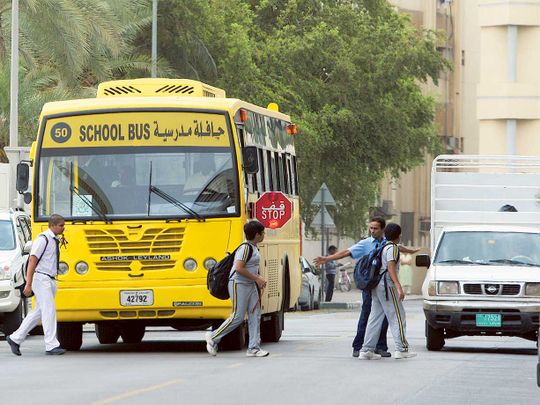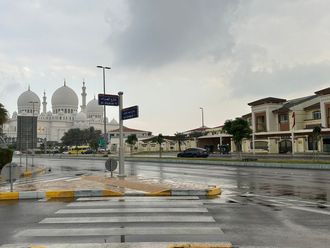
Abu Dhabi: The inevitable increase in road traffic as children travel to and from school every day has once again put road safety into sharp focus.
Aside from adhering to traffic rules and regulations, parents and transport providers must ensure the safety of children during pickup and drop-off as well. It is also beneficial to be aware of regulations guiding transport providers, especially as traffic authorities have called on parents and guardians to report any violations they come across.
Top risks
So what are the top risks during travel to and from school? Here are some highlighted by police in Abu Dhabi Police and Dubai:
• Failing to put on a seat belt, or failing to use age-appropriate car seats for children aged four years and younger
This is a traffic offence, and violators are given four black points, and fined Dh400 for each passenger who is not properly secured in the vehicle.
• Allowing children aged below 10 years to sit in the front passenger seat
In Abu Dhabi Emirate, violators are penalised with a Dh400 fine, and the vehicle is impounded until a Dh5,000 impound release fee is paid.
• Reckless driving and speeding in school zones that can endanger the safety of children crossing roads or heading to buses or parked vehicles
• Failing to come to a complete stop when a ‘Stop’ sign put up by a school bus when children are boarding or getting off
Motorists who fail to stop at least 5m away from the bus in either direction are fined Dh1,000, and given 10 traffic black points. Violations are monitored through cameras installed on buses. In addition, school bus drivers who fail to put up the ‘Stop’ sign are also fined Dh500, and given six traffic black points.
• Failing to check that children have safely disembarked before locking up the vehicle, which can result in fatal heat exhaustion and other injuries
Such cases have been reported in the UAE before, and many transport providers therefore equip vehicles with sensors and systems to ensure that no children have been left behind. Bus attendants and drivers are also tasked with checking vehicles thoroughly before locking up after a school run.
• Being unavailable to collect children below the age of 11 years from drop-off points
Bus attendants are tasked with ensuring that a parent or guardian is available at the drop-off point to take charge of young children.
• Parking randomly or in non-designated spaces near the school during pickup and drop-off
This tends to cause traffic congestion, and increases the risks of accidents.
• Driving recklessly without paying attention to weather conditions like morning fog
• Ignoring the bus attendant’s instructions during the bus journey
Parents must also advise children to respect and adhere to the bus attendant’s instructions during every bus trip.
Transport safety awareness
In order to ensure the highest levels of safety, traffic authorities recently reached out to families to increase their awareness about traffic regulations. Many transport providers that serve schools also work with schools to highlight safety measures.
Steve Burnell, managing director at STS Group, which serves many schools across the UAE, said: “All vehicles in our fleet of 2,900 school buses are fitted with seat belts, and it is mandatory that all passengers buckle up for every journey. The risk of not wearing seat belt is well publicised and we also rely on parents reminding children of this important safety feature.”
He added: “Wearing a seat belt in any vehicle must be a basic human instinct, and we all have the responsibility to continually talk about the importance of this. The bus guardian assists younger students in seat belt use and assists where a booster seat is required. Older students are reminded for each journey.”
Burnell said young children can find it especially challenging to board and disembark safely, and that students must be educated about where to stand and how to behave while waiting for the school bus.
For its part, the STS Group carries out various workshops about travel safety for children. It has also equipped all its buses with motion sensors and Child Check Buttons to ensure that no student has been left behind by accident.
Safety features
“All our buses have a Child Check Button located at the rear of the bus, and passive motion sensors that activate when the bus is turned off. All systems are connected to our 24/7 operational control centre,” Burnell said.
In addition, bus drivers follow a sequence of safety procedures after every trip.
“At the end of all journeys, the bus driver follows a specific sequence of safety procedures. Turning the engine off activates the bus motion sensors. The driver manually checks all seats and aisles to ensure no student has been left behind. After checking the entire bus, the driver presses the Child Check Button to indicate the bus is empty and confirm that no student is on board,” Burnell explained.
Avoid hurrying
Despite awareness efforts, school pickup and drop-off can be stressful, especially amid peak hour traffic.
“Parents in a hurry may not observe safety instructions and may stop their cars in an unsafe manner or location,” said Lalitha Suresh, principal at GEMS Our Own Indian School.
She warned that unauthorised carpools can also present safety risks.
“[To ensure child safety], we hold sectional assemblies on road safety, while [our transport provider] conducts road safety awareness programmes with both students and staff,” Suresh said.










